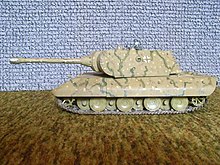Panzerkampfwagen E-100
The Panzerkampfwagen E-100 was a German tank project from World War II . It belonged to the E series , with which attempts were made in the German Reich from around 1942 to replace the previous tank types.
development
Around 1942, the development of the E series began to replace the tank types III and IV and the larger Panther and Tiger tanks that were available at the time and to standardize assemblies. These projects should range from the 5-ton weapon carrier to the 140-ton E-100. Assemblies should be simplified and applied to multiple types; a common parts strategy should reduce costs and increase ease of maintenance.
The E-100 was a purely experimental vehicle. The experience of the front troops, the latest technology and the current demands of the Army Armed Forces Office were incorporated into it . The E-tanks were therefore pure drawing board studies of the German Wehrmacht. Only the development of the E-100 continued and in 1943 the production order followed. However, Hitler's later ban on the development of super-heavy tanks due to scarcity of resources ensured that the prototype was continued with only three workers. The tower was similar to that of Panzerkampfwagen VIII Maus , but was no longer manufactured. The engine of the Panzerkampfwagen VI Tiger II was installed for test purposes . This tank was supposed to be manufactured by the Adlerwerke .
The E-100, originally designed by Adler, weighed around 100 tons. The tower developed by Krupp for the mouse should also be used on the E-100 and now accommodate a 15.0 cm KwK. Since the draft, however, provided for by Adler only a 12.8-cm-high-tank gun, among other things, had to bath be extended to accommodate to the new tower. The 50-ton tower and the extended hull increased the total weight to 140 tons.
technology
In contrast to the even heavier mouse , the E-100 was a conventional design with a rear-mounted motor. The side armor and the chains could be removed for rail transport. A 15.0 or 17.0 cm cannon should serve as armament, alternatively the 12.8 cm cannon of the Jagdtiger . However, the turret of the E-100 was too small to accommodate a 17.0 cm cannon; In this case, the vehicle should have been designed in a casemate construction, i.e. without a rotating tower. There was also space for several machine guns in the six-man colossus. By May 1945 only a tub and the chains could be completed, there was no time for a tower. After the end of the war, the drive with a Belleville Washer suspension was shipped to England for tests. It was found that the 700 hp engine of the King Tiger could only accelerate this super-heavy tank to 20 km / h. In addition, apart from railway and motorway bridges, there were no bridges that could have carried it, which would have made it, like the mouse, a moving fortress. This would have called the tactical value into question, since the heavy Tiger II had already reached the maximum for a tank.
The prototype was powered by the well-known Maybach HL 230 . However, the 700 hp did not produce the performance expected. So a more powerful engine was needed, but it still had to find space in the narrow engine compartment. That is why Maybach was working on a supercharged tank engine. The HL 232 should produce around 1200 hp; the fuel consumption should have been around ten liters per kilometer. With a tank of around 1200 liters, the tank would have had a driving range of around 120 kilometers. More than 40 km / h on the road would not have been possible with the HL 232 either.
Technical specifications
- Weight: 140 tons
- Engine: Maybach HL 230 P30 with 700 PS (prototype), planned: Maybach HL 232 with supercharging and around 1200 PS
- Top speed: 20 km / h (40 km / h planned)
- Chain width: 100 cm
- Ground pressure : 1.43 kg / cm²
- Ground clearance: 57 cm
- Overall length: 8.7 m
- Width overall: 4.48 m
- Height: 3.32 m
- Crew: 6 men
- Year of construction: 1945
- Quantity: 1 incomplete prototype
literature
- George Forty: The German tank weapon in World War II , Bechtermünz, ISBN 3-8289-5327-1 , p. 144ff.
- Fritz Hahn: Weapons and secret weapons of the German army 1933-1945. Bernard & Graefe, Bonn 1998, ISBN 3-7637-5915-8 , pp. 88f.
Web links
- Germany's E-100 super heavy tank ( Memento from February 9, 2013 in the web archive archive.today ) (English)
- Information about the E-series on Attention tanks! (English)


